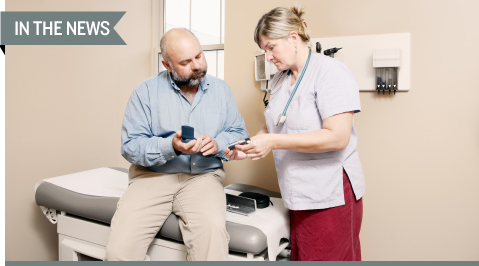
iStock.com/Fertnig
The American Diabetes Association (ADA) in its 2019 standards of medical care for diabetes has revised criteria to support a diagnosis of diabetes when it’s possible to obtain two abnormal tests from a single sample. Given that clinicians may be unfamiliar with this recommendation, “clinical laboratorians can play an important role in educating members of the healthcare team about this change if and when these criteria are met in a given patient,” Joshua J. Neumiller, PharmD, CDE, chair of ADA’s Professional Practice Committee (PPC) told CLN Stat.
PPC’s panel of physicians, diabetes educators, registered dietitians, and public health experts are charged with updating these standards each year. Documents on the 2019 standards of care appeared in the ADA’s Diabetes Care journal.
The provision to include two abnormal test results (i.e., fasting plasma glucose and A1C) from the same sample as an appropriate threshold for the diagnosis of diabetes appears in the section on the Classification and Diagnosis of Diabetes. Recent evidence indicated that using this protocol had a high positive predictive value for subsequent diagnosis and strongly associates with clinical end points, Neumiller said. “This approach may allow for faster diagnosis and implementation of an appropriate treatment plan when such laboratory values are available,” he added.
Specifically, the guidelines recommended that “unless there is a clear clinical diagnosis (e.g., patient in a hyperglycemic crisis or with classic symptoms of hyperglycemia and a random plasma glucose ≥200 mg/dL [11.1 mmol/L]), diagnosis requires two abnormal test results from the same sample or in two separate test samples.” For the latter option, clinicians for the second test should either repeat the initial test or do a different test immediately after the first one. “If a patient has discordant results from two different tests, then the test result that is above the diagnostic cut point should be repeated, with consideration of the possibility of A1C assay interference,” the committee members clarified.
This section of the standards document identifies additional conditions that may affect A1C test accuracy, including glucose-6-phosphate dehydrogenase deficiency and the postpartum period, Neumiller said.
In another important change, the ADA standards now include a dedicated section on diabetes technology, which covers insulin delivery methods such as syringes, pens and insulin pumps, blood glucose meters, continuous glucose monitors and automated insulin delivery devices such as the artificial pancreas. “Given the ever-increasing role of technology in the management of diabetes, the PPC felt it appropriate to have a dedicated section of the Standards devoted to technology starting in 2019,” Neumiller said.
The committee recommended insulin syringes or insulin pens for diabetics requiring insulin, taking into account factors such as insulin type and dosing regimen, patient preference, cost, and self-management capabilities. Patients with impaired vision or dexterity issues also may benefit from insulin pens or insulin injection aids, to help them accurately administer their doses.
Addressing continuous glucose monitors, the committee recommended that children, adolescents, and adults consider sensor-augmented pump therapy “to improve glycemic control without an increase in hypoglycemia or severe hypoglycemia. Benefits correlate with adherence to ongoing use of the device.”
“This section of the standards will continue to evolve in the future in tandem with the rapid advancement of diabetes technologies,” Neumiller said.
In the section on Comprehensive Medical Evaluation and Assessment of Comorbidities, ADA added new text to advise healthcare professionals on how they should communicate to diabetic patients in an empowering and informative manner. This entails a patient-centered active listening approach that incorporates not just patient preferences and beliefs but also factors in literacy, numeracy, and other potential barriers to care. “Diabetes care should be managed by a multidisciplinary team” that includes healthcare professionals from all sectors, not just primary care physicians, according to the updated standards statement. ADA had evaluated a new consensus report on diabetes and language to guide its revisions on communication.
“The goals of treatment for diabetes are to prevent or delay complications and maintain quality of life. Treatment goals and plans should be created with the patients based on their individual preferences, values, and goals,” the authors stressed.
The standards’ glycemic targets section places new emphasis on the role of A1C testing in glycemic management. The authors recommended that clinicians conduct an A1C test at least twice a year in stable patients meeting treatment goals. For those patients who aren’t meeting glycemic goals or whose therapy has changed, the test should be done quarterly. “Point-of-care testing for A1C provides the opportunity for more timely treatment changes,” the authors recommended. The committee also calls on clinicians to re-evaluate glycemic targets over time, given that the risks and benefits of these targets can change as patients age and as their disease shows signs of progression.
An A1C reading of <7% is a reasonable target for many nonpregnant adults, according to the standards.
Other revisions reflected in the 2019 standards of care include:
- A new figure from the ADA-European Association for the Study of Diabetes (EASD) consensus report about the diabetes care decision cycle that underscores the need for ongoing assessment and shared decisionmaking to achieve the goals of healthcare and avoid clinical inertia;
- A new table that list factors that increase risk of treatment-associated hypoglycemia;
- A recommendation that includes the 10-year atherosclerotic cardiovascular disease (ASCVD) risk as part of overall risk assessment; and
- Updates to the fatty liver disease section that include a new recommendation specifying when to test for liver disease. The committee recommended that clinicians evaluate patients with type 2 diabetes or prediabetes and elevated liver enzymes or fatty liver on ultrasound to search for the presence of nonalcoholic steatohepatitis and liver fibrosis.